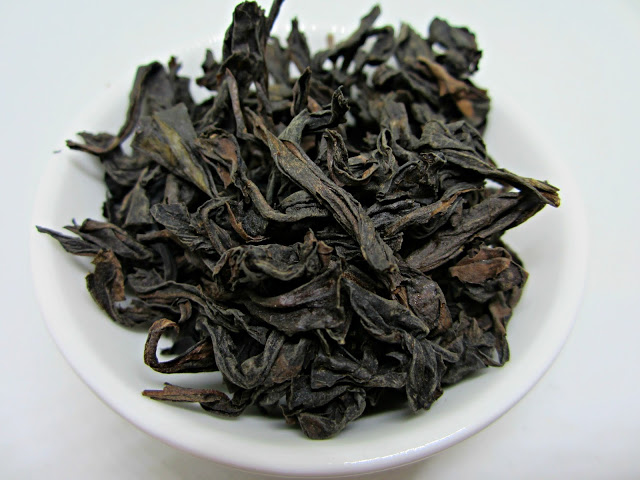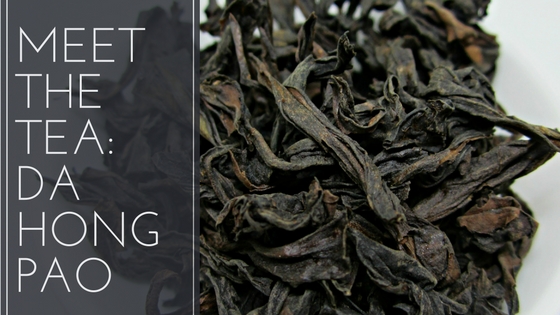Da Hong Pao, aka Big Red Robe, is a type of oolong produced only in the Wuyi Mountains. Teas from this region are often called yancha, or rock tea, due to the rocky soil on the cliffs where the tea is grown. According to legend, the mother of a Ming Dynasty emperor was cured of an illness after drinking this tea. To show how special these tea trees were, he had the bushes that this incredible tea was made from draped with red cloth. Yet another version tells of a scholar who passed his exams thanks to this tea. He draped the bushes with the scarlet robes that he was awarded.
Even more incredible than these legends, six of the original mother trees are still believed to be alive today. They are estimated to be about 300 years old but no one really knows for sure. The Chinese government now protects these plants and no harvest has taken place since 2005. Although, I came across a blog post from Essence of Tea that indicates the government may still be doing non-commercial harvesting for research purposes.
Cuttings were taken from these original trees, creating genetically identical clones. Teas made from these clones are referred to as Qi Dan and they can fetch a hefty price tag. That being said, the vast majority of the tea sold as Da Hong Pao on the market are actually blends of several Wuyi oolong varieties. For this reason, it can be a bit hard for consumers to determine authentic what is an authentic tea because many vendors claim to have the real deal.
Da Hong Pao is made in the typical style of Wuyi oolongs, higher oxidation with extensive charcoal roasting. If you didn’t know any better you might think that it was a black tea. The taste is roasted and earthy with notes of tobacco. A strong mineral taste, also known as yan yun, is a hallmark of this tea along with an underlying floral quality. The roasting process can add a bit of char so many tea drinkers prefer to the let the tea settle for at least six months.
Fully boiling water is the rule of thumb when brewing Da Hong Pao. Western infusion times will range between 3 and 5 minutes. I recommend going a bit heavier on your leaf ratio though, at least two teaspoons for every 8oz of water. Although it can certainly be made in a western fashion Da Hong Pao really shines when prepared in a gaiwan or other gongfu sized vessel. I’ll usually pack at least 8g into my gaiwan. Infusion times will usually fall between 15 and 30 seconds, gradually lengthening the time as you go. Clay pots can help reduce the roast a bit if the tea is too intense for you.
These are some of the Da Hong Pao that I’ve reviewed here on the blog:
Adagio Teas Masters Collection: Wuyi Da Hong Pao
Teavivre Da Hong Pao (Big Red Robe) Wuyi Rock Oolong
KEDOÇAY Big Red Robe
Four Seasons Tea Co. Mu Ben Da Hong Pao
It’s currently sold out but I also highly recommend the Da Hong Pao from my friends at Zhen Tea.
Do you have a favorite Da Hong Pao? Tell me all about it in the comments!


A great post on a classic and elusive tea that die hard tea drinkers should at least experience in a real way before the fakes flood the market
I am drinking a DHP (a straight Qi Dan) right now. It's from Cindy Chen at Wuyi Origin. One of my too many eccentricities is that I've always thought the name Big Red Robe sounds very clunky. If you read the first two characters as one word rather than two you get Dahong (scarlet) instead of Da Hong (Big Red.) Out of stubbornness I always call this tea Scarlet Robe in English.
Thank you, Shawn! It's definitely a tea that everyone needs to try.
I've heard really good things about Cindy's teas. Nomenclature can definitely get a bit tricky. I've seen some companies use Scarlet Robe to refer to a DHP that is more lightly oxidized.
The 1st time I ordered tea ware from Music City tea I received a nice little sample bag of Big Red robe. Its truly a fantastic Wuyi Oolong variety and actually one of my favorite Oolongs. I picture a Ming Dynasty emperor outside in a garden early in the morning sipping a cup and relaxing in a Big Red robe. I prefer Gong fu/gaiwan vs. Western style brewing with this tea. It provides numerous great tasting cups after each brew. Agree with Shawn, its a great tea to try and especially if you prefer Oolong varieties.
Thanks for sharing @One You tea! Music City Tea is a great. I purchased my travel gaiwan set from them a few years ago 🙂
Your welcome.. I have to budget myself at that site.. 🙂
DHP should be considered a form of processing and that explains the many blends of cultivars used and marketed.
There are three distinct “mother” cultivars from the originals now preserved by the authorities. Qi Dan is one.